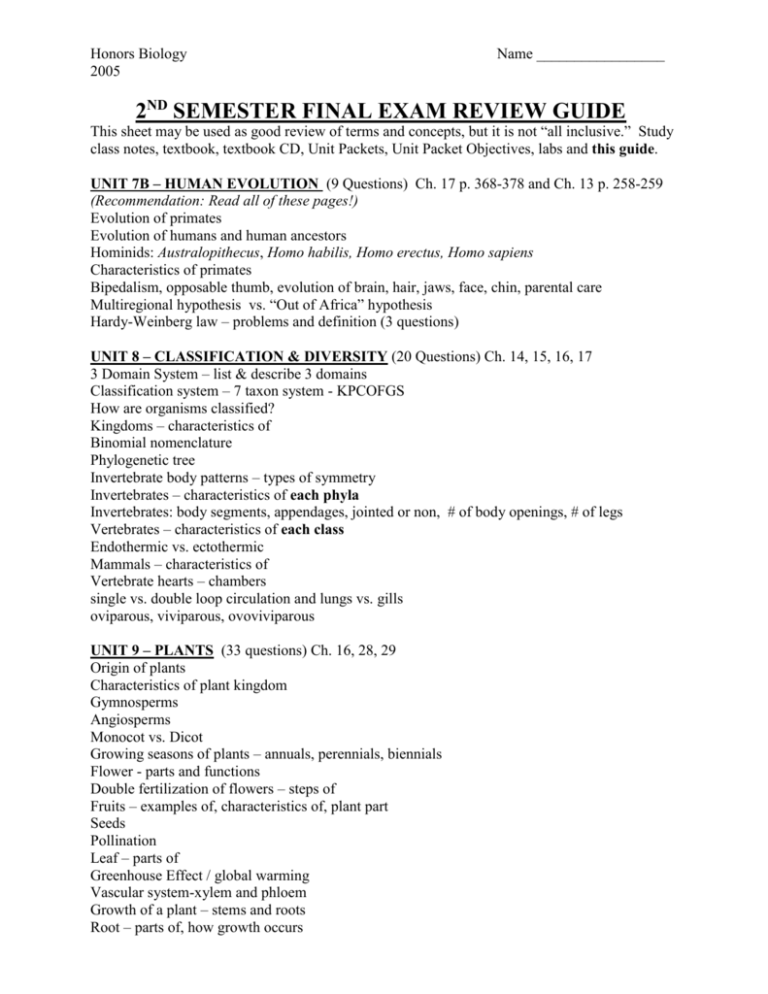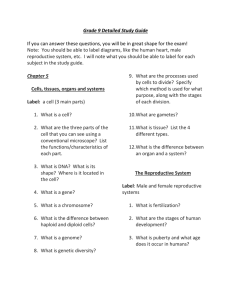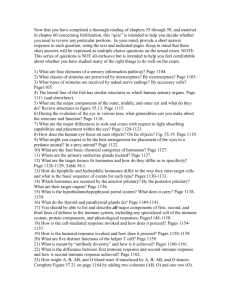second semester final review sheet
advertisement

Honors Biology 2005 Name _________________ 2ND SEMESTER FINAL EXAM REVIEW GUIDE This sheet may be used as good review of terms and concepts, but it is not “all inclusive.” Study class notes, textbook, textbook CD, Unit Packets, Unit Packet Objectives, labs and this guide. UNIT 7B – HUMAN EVOLUTION (9 Questions) Ch. 17 p. 368-378 and Ch. 13 p. 258-259 (Recommendation: Read all of these pages!) Evolution of primates Evolution of humans and human ancestors Hominids: Australopithecus, Homo habilis, Homo erectus, Homo sapiens Characteristics of primates Bipedalism, opposable thumb, evolution of brain, hair, jaws, face, chin, parental care Multiregional hypothesis vs. “Out of Africa” hypothesis Hardy-Weinberg law – problems and definition (3 questions) UNIT 8 – CLASSIFICATION & DIVERSITY (20 Questions) Ch. 14, 15, 16, 17 3 Domain System – list & describe 3 domains Classification system – 7 taxon system - KPCOFGS How are organisms classified? Kingdoms – characteristics of Binomial nomenclature Phylogenetic tree Invertebrate body patterns – types of symmetry Invertebrates – characteristics of each phyla Invertebrates: body segments, appendages, jointed or non, # of body openings, # of legs Vertebrates – characteristics of each class Endothermic vs. ectothermic Mammals – characteristics of Vertebrate hearts – chambers single vs. double loop circulation and lungs vs. gills oviparous, viviparous, ovoviviparous UNIT 9 – PLANTS (33 questions) Ch. 16, 28, 29 Origin of plants Characteristics of plant kingdom Gymnosperms Angiosperms Monocot vs. Dicot Growing seasons of plants – annuals, perennials, biennials Flower - parts and functions Double fertilization of flowers – steps of Fruits – examples of, characteristics of, plant part Seeds Pollination Leaf – parts of Greenhouse Effect / global warming Vascular system-xylem and phloem Growth of a plant – stems and roots Root – parts of, how growth occurs Stem – parts of, how growth occurs Sap (Food) – movement of Water – movement of Transpiration – cohesion – adhesion Stomata – how they work Plant hormones – how each works UNIT 10 – ENERGY, PHOTOSYNTHESIS, RESPIRATION (30 questions) Ch. 2, 6, 7 Atom – structure of Chemical formulas, compounds Bonding – covalent vs. ionic Photosynthesis in detail, using diagrams Light – wavelengths of Chlorophyll and leaves Respiration in detail, using diagrams Fermentation Lactic Acid and Alcohol formation ATP Chloroplast vs. Mitochondria Compare photosynthesis and respiration UNIT 11 – TISSUES, EXCRETION, DIGESTION (17 questions) Ch. 21, 22 3 types of muscle tissue Digestion – pathway of food through alimentary canal, using diagram Digestive organs and functions Digestive enzymes / chemicals and functions Peristalsis pH level in digestive organs Kidney – function of Nephron – parts and function of Pathway of filtrate through nephron – in detail, using diagram Urine – composition of Reabsorption, secretion, excretion Essential amino acids UNIT 12 – CIRCULATION (14 Q), RESPIRATION (4 Q), NERVOUS (17 Q) = (35 Total questions) Ch. 23, 27 Human heart – pathway of blood Know chambers, valves, nodes Pulmonary vs. systemic circulation Fetal heart circulation pathway Right vs. Left side of heart Blood pressure – define, how is it measured Systole vs. diastole Heart attack – causes of, tests for Blood – 4 parts of blood, functions of each Blood – 4 Blood types, Blood typing technique Blood typing – recipients and donors (who can receive which type of blood) agglutination of blood Rh factor Antigens and antibodies Lungs – breathing steps Pathway of oxygen through respiratory system Oxygen exchange between capillaries and alveoli Oxygen and carbon dioxide levels in the blood, and breathing regulation Neurons – parts of, direction of impulses, neurotransmitters at synapse Neurons – all or nothing law Resting potential and Action potential Reflex arc - parts of, how it works Brain – major parts of and functions of each part EEG vs. EKG UNIT 14 – BEHAVIOR (16 questions) (Ch. 25 + Behavior Notes) Endocrine system – hormones, definition of How do hormones work, what do they do? Know major hormones from each endocrine gland, functions of Thyroid gland – malfunctions of, role of iodine Interaction of glucose, glucagon, epinephrine, insulin, liver, & pancreas in blood sugar regulation Glucose in urine - indications Behavior – instinct, innate, learned, habits, imprinting, reasoning, conditioning, trial and error Tropism vs. Taxis Behavior -Pecking order in hens TOTAL QUESTIONS = 160









